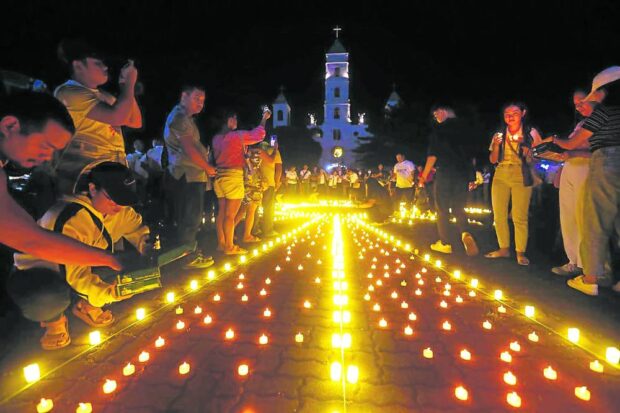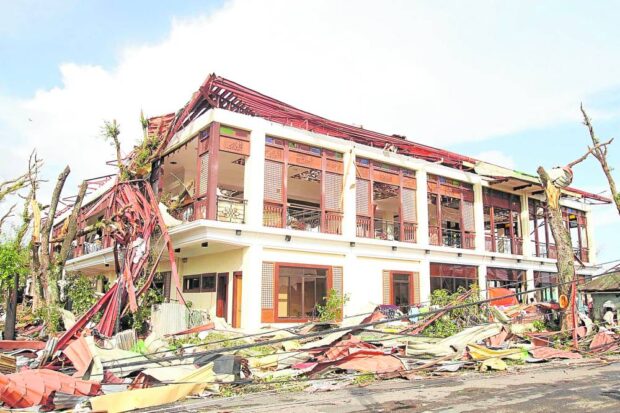
HONORING THE DEAD | Candles are lighted at Plaza Rizal in Tacloban City on Nov. 8 as residents remember those who died after Supertyphoon Yolanda (international name: Haiyan) battered the Visayas on the same day 10 years ago. (Photo by NIÑO JESUS ORBETA / Philippine Daily Inquirer)
TACLOBAN CITY, Leyte, Philippines — Ten years ago, on Nov. 7, I was at the Manila Police District press office in Ermita when I received an assignment from my editors asking me to prepare for immediate deployment to Tacloban City. A strong typhoon—a Category 5—was about to make landfall in two days.
As a photojournalist, it was not my first time to cover or witness natural calamities. Since I grew up in Guinobatan, Albay, in the Bicol region, I experienced firsthand other typhoons, such as “Milenyo” (international name: Xangsane) and “Reming” (Durian) in 2006, and Tropical Storm “Ondoy” (Ketsana), the last hitting Metro Manila in 2009.
But nothing compared to what I experienced with Supertyphoon “Yolanda” (Haiyan) and the devastation it wrought on Tacloban and the rest of the Visayas.
Yolanda, just to describe its sheer power, was “an act of God” that etched Nov. 8, 2013, in Philippine history, as it left over 6,000 people dead and a million homes damaged in its wake.

TRAGEDY | Yolanda leaves the town hall of Palo, Leyte, in ruins. (Photo by NIÑO JESUS ORBETA / Philippine Daily Inquirer)
READ: Work not yet done in helping Yolanda victims – Marcos
Early hours
It was in the early hours of that Friday when I was awakened by the rattling of windows in our hotel room caused by the unusually strong winds. I hurriedly woke up my coverage partner, then reporter (now desk editor) DJ Yap, who was in the other bed.
“It’s here,” I told DJ.
We hurried to the fire exit, which we knew had a good view of downtown Tacloban. But there was virtually nothing to see: the view was hazy, as though everything had turned white.
We barely made out from the haze all sorts of debris that flew by—notably sheets of roofing blown away from homes.
After a few minutes we heard the scampering of other hotel guests rushing to the upper floors, for water surging from Cancabato Bay had started to flood the lobby. (It proved to be good a decision on our part that we picked a room on the fourth floor.)
DJ and I decided to go down after a few hours, when we thought the worst of Yolanda’s wrath was over.
The Palo Metropolitan Cathedral becomes a depository for the dead. (Photo by NIÑO JESUS ORBETA / Philippine Daily Inquirer)
READ: Yolanda made disaster preparedness top of mind
Death and misery
Almost immediately after stepping out into the streets we began seeing bodies.
We saw two men pushing a cart normally used for vending but it carried a mother and her son, both dead.
These were the first of many corpses we would encounter that day. I took photos of them—along sidewalks, pinned by debris, covered in blankets, in almost every corner of Tacloban’s streets.
As we went around, we saw that everything was ruined as houses were stripped of roofing and the once busy shops downtown had all been looted. There was no electricity or even potable water for weeks.
At first, I thought that Tacloban would never recover or become a permanent danger zone.
Recovery
Ten years later, I was glad to be proven wrong. Tacloban has risen from the nightmare of Yolanda.
I arrived here early this week, on Nov. 6, two days before the city marked the 10th anniversary of Yolanda. From the airplane window, I could see taller buildings, with homes now rebuilt and many of them with a second floor. On the ground, the streets are bustling as new shops and restaurants are enjoying good business. And there’s the gridlock, as Tacloban’s streets get choked with vehicles.
A new 18-kilometer-long seawall was built along the city’s coastline to protect this major urban center of Leyte, the ground zero of Yolanda, from future storm surges.
From what I saw this week, I can say that the city has recovered. Although as an outsider, I could not judge if it has been a full recovery indeed.
Most families, I was told, had moved on from the tragedy. But they will never forget.
Today, the Anibong shipwreck site still serves as a reminder of the tragedy. A new memorial for Yolanda victims was built at Holy Cross Cemetery in Barangay Basper, which stands near a mass grave. Etched on a black granite wall are the names of the 2,273 people in the city who died 10 years ago.
I can only pray that Yolanda will never happen again. I hope that the government and local communities have learned a painful lesson, enough for them to make sure that if and when the next supertyphoon comes, we are better prepared than we were in 2013.
MEMORIAL | A memorial for “Yolanda” is built at the Tacloban City Convention Center complex. (Photo by NIÑO JESUS ORBETA / Philippine Daily Inquirer)
MASS GRAVE | A nun offers prayers and blesses the mass grave for “Yolanda” victims in Barangay
Basper. (Photo by NIÑO JESUS ORBETA / Philippine Daily Inquirer)
ICON The MV Eva Jocelyn has become an icon of the tragedy that struck Tacloban in 2013. (Photo by NIÑO JESUS ORBETA / Philippine Daily Inquirer)
SOLIDARITY WALK | Environmental activists cross the San Juanico Bridge on their way to Tacloban to call for climate change awareness on the 10th anniversary of “Yolanda,” one of the world’s strongest typhoons to hit land. (Photo by NIÑO JESUS ORBETA / Philippine Daily Inquirer)

